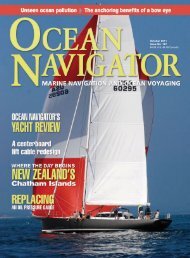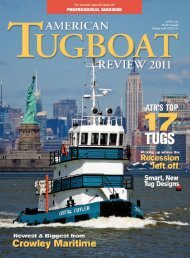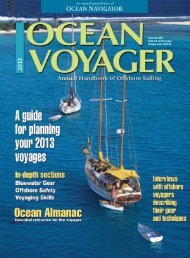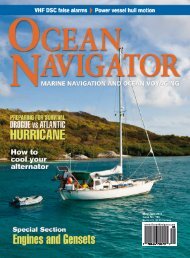Ask For A Test Demo - Navigator Publishing
Ask For A Test Demo - Navigator Publishing
Ask For A Test Demo - Navigator Publishing
You also want an ePaper? Increase the reach of your titles
YUMPU automatically turns print PDFs into web optimized ePapers that Google loves.
CORDAGEAbove, thetechnical teamat New EnglandRopes testsnew and usedlines, measuringthe effect offatigue,abrasion, UVand otherfactors. Right,strength andelongationcharacteristicsare importanttraits, but so isthe manner inwhich a linecoils andbehaves on awinch.slower to occur, but in the tertiaryphase, filament snappingcan actually be heard and elongationbecomes more rapid,continuing to accelerate up tothe point of complete failure.The bottom line when it comesto creep is to choose a cordagetype and diameter that keepsthe working load well south of50 percent of the breakingstrength under the mostadverse circumstances, andunder 25 percent if truelongevity is of interest. Creeptends to be more common inOlefin-based lines and almostnil with high-end fibers such asZylon-based PBO.In the lab, researchers continuethe quest for polymersthat form repeatable long chainlinks, and in some cases evenform crystalline lattices withimmense tensile strength. Carbonfiber is a classic example ofsuch a eureka moment.Researchers discovered that byheating inexpensive polyacrylic-nitrilefiber to about2,000° C in the presence ofpitch, the common inexpensiveT-shirt fiber turns into crystallinecarbon — a filamentwith an exponential increase intensile strength. Such lead-togolddiscoveries represent theforward strides made in chemistry,advances that have beenleveraged by the cordage industry.But regardless of the recipe,good cordage, like good pancakes,relies just as much onhow the batter is handled.When it comes to ropemanufacture, the raw materialis the fiber bought in bulk byeach cordage company, andpicking the right filament formulaand fiber blend is a bigdeal. The process mimics theold software adage “garbage in,garbage out.” Quality cordagerequires top notch raw materials,plus quality control in howyarns are twisted, braided orparalleled. Each manufacturerspends an inordinateamount of time making surethat the spools of raw materialthat they invest in areboth high in quality and costeffective. Every manufacturerknows what batch inconsistencyor supply disruptionscan do to their brand andtop label companies likeNew England Ropes, Samsonand Yale work as hard tomaintain product consistencyas they do to introducethe next new miracle fiber.The bottom lineBy comparing the tensilestrength of a variety of7/16-inch lines, a crew willget a feel for how wide arange of rope options areavailable. Independent testinghas shown that three-strandnylon rates a 5,900-poundbreaking strength, while ahigh-quality Dacron (polyester)braid such as Sta-Settallies up a 6,600-pound tensilestrength rating. New EnglandRopes’ Endura 12 andtheir Pro-PBO, Samson’sProgen II and Yale’s PoBOndeliver an astounding tensileload rating of 24,000 pounds.These lines are the samediameter as the Dacron andnylon mentioned above, butthey are four times stronger!Elongation, or stretch, isanother big deal when it comesto line choice. Here we are talkingabout the elastic phase ofstretch that occurs with repetitiveloading. It’s in this realm42 OCEAN NAVIGATOR SEPTEMBER 2010













